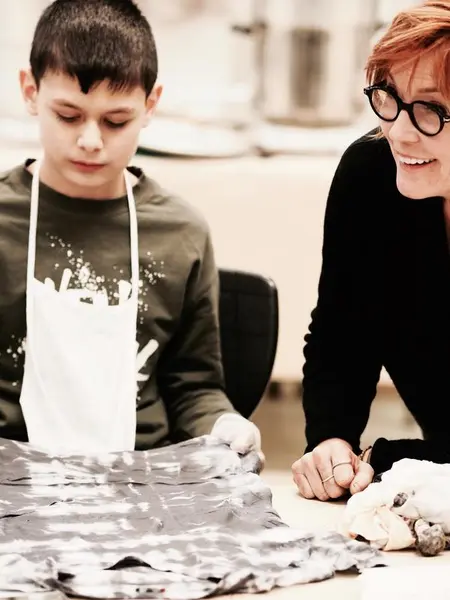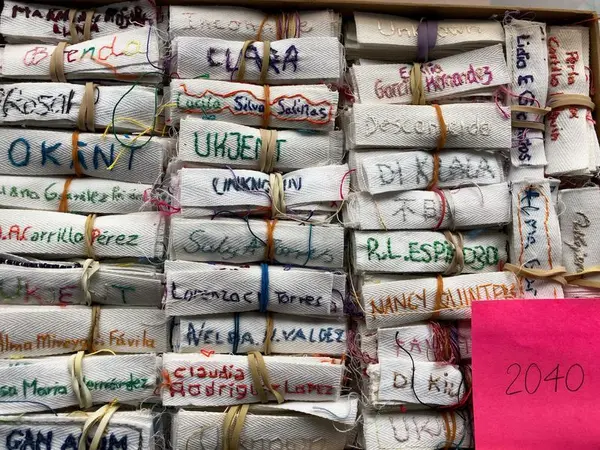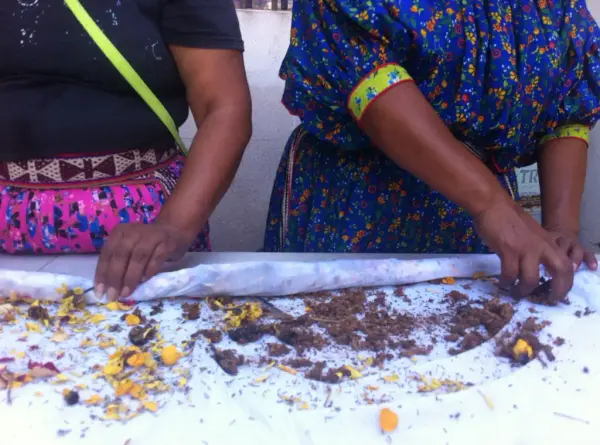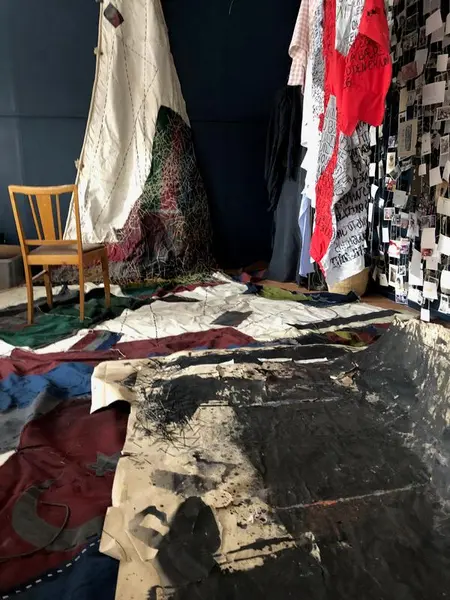- 1/1
Photo: Jannik Abel
- How would you describe the place you work/ your studio? Where is it located? What is the best time of the day for you to work?
I bring work with me wherever I am, but my “official” studio is located in a previous office building in Oslo. Right now, the studio is a bit chaotic. I think it resembles the current working period I am in with many different projects running and demanding attention at the same time. I have a half wall painted pink, with labels from Desconocida installed in grids testing size for the wall in the triennial. In the boxes I have labels sorted, counted and prepared to be installed. On another wall I have a huge textile collage hanging, covering the wall and half the floor, waiting to be concealed by stitches. In between stands cooking pans and iron pots, heaters, vinegar, nuts and other material for natural dyeing. Tests of colors on cotton and silk, are hanging from a third wall. I am more efficient in the mornings, but often end up working late. Due to a lot of administrative work with NI EN MORE, a project I have initiated in Cd Juarez, Mexico, much time is also spent in front of the computer, often at home by my kitchen table. With 8 hours time difference with Juarez, meetings with the team back there are often scheduled late at night for me. I have a favorite chair at home too, where I often sit and do needle work or drawings.
- What inspires you in your work? What is the main motivation to create?
My projects usually start from social, political or personal issues, something I find challenging or unfair, that I would like to get a better understand of. I am interested in using art and my practice as a way to diminish distance and engage us, create projects that could become tools for dialogue. I am interested in the public realm, reaching people where they are. As a result, I often invite people to create with me. I find conversations during such workshops to hold an authenticity and honesty different from other conversations, doing something with your hands does something to your mind and ways of communicating.
- 1/1
Photo: Lise Bjørne Linnert
- What are the challenges you face in your artistic practice?
Wanting to bring challenging and complex issues closer holds a danger to oversimply and become superficial. For me, as I often work in a direct manner like in Deconocida, embroidering the names of the actual victims onto nametags, a challenge has been to present the labels in a way that still give space for the unsaid. The wall of labels becomes a statement, active like a verb, reaching out and inviting the viewers to come close. The process of making is a crucial part of my work, and a challenge can be to balance that with the final presentation and keep both visually present. I work on projects for a long time, often many years, another challenge can therefore be to remain fresh, and to express an urgency.
And then, of course, as for so many of us, the funding, applying for project grants etc.
- Have you experimented with other mediums? Maybe thought about working in other fields?
Although textile is my main material, I also use photography, video, performance, and text in my work, sometimes combinations. The last couple of years I have also used fashion and design of clothes as tools for empowerment of women, social change and raising awareness about the cause. In a lot of my work I collaborate with others and need their fields of expertise to fulfil the work. I really enjoy that, it brings so much learning my way. Last summer I worked as a costume assistant in a feature film about the composer Wagner, with a brilliant French costume designer, Odette, and fantastic costumes from the 1850s, some actually from that time. That was a fun experience- fixing the costumes on the actors at the last minute, sometimes literally sewing it on them; large scenes where we were dressing 50 people in a couple of hours. I really enjoyed the tempo, the teamwork, the pieces that needed to come together, the gap between what we really did and how it ended up looking in the movie. However, I was also very happy to be back in my studio and my own work when the job was over.
- 1/1
Photo: Jane Terassaz
- What are you reading right now? Which are some of your favourite thinkers, artists and musicians?
I love books, and I mean real books, I need to underline and write comments, turn the pages and feel the weight. I am hopelessly optimistic about how much I will be able to read, I always travel with at least 4-5 books in my bag, ending up maybe reading one and often finding a new one to bring home. At the moment I am reading a beautiful book of essays by Inger Christensen called “Hemmelighetstilstanden” and I just finished the striking novel by Sara Stridsberg “Kjærlighetens antarktis”. I have brought Marit Paasche’s thoughtful book about Hannah Ryggen to read again, as a way to prepare for the triennial. Another favorite author of mine is Rebecca Solnit, an American writer that has written on a variety of subjects, including the environment, politics, place, and art. Of all her books “Wanderlust”, about the history and importance of walking, is a favorite of mine. I find Simone Weil and Iris Murdoch’s writings on the attentive gaze very fascinating. They describe this gaze to be just and empathic/loving at the same time. It is a gaze that has the capacity to listen, to be open to what is seen, but who cuts through when needed without avoiding the uncomfortable. Another thinker I love is Fernando Pessoa, and particularly “The book of Disquiet”. I did a project on Cruelty in 2014 – 2015, collaborating with the philosopher Lars Fr H Svendsen. He is like a walking encyclopedia: on any topic related to art, politics, history and philosophy. Maybe this is the reason his books express difficult themes with such clarity and philosophy feels connected to the everyday life? Of film directors I love Michael Haneke’s films, in particular the “White Ribbon” and “Amour”. Mike Leigh is another favorite director. The poet and artist Jonas Mekas, who recently died, was wonderful. I remember his talk at OCA some years ago, in his 90s with sparkling eyes and a curiosity and appetite for life like a teenager, and this is so visible in his work too. Working so closely with Mexico, I find Teresa Margolles work extremely powerful, painful and beautiful. At home among many, I admire Lotte Konow Lund´s work and how they point to the common ground we share but also to the deep gaps that run through society. Maybe because I like silence, music has never been very important for me. But in a biennial, a fellow exhibiting artist, sent me the music of the American/French/Mexican singer-songwriter Lhasa de Sela, because he felt it connected to content of Desconocida. I loved it, contacted her and was given permission to use the song Con Toda Palabra (With all words) in a video I made about the women’s fight for justice. So that song and she is for all times my favorite.
- What exhibitions and projects are coming up for you in 2019?
I am currently starting a two years project with inmates in a prison in Oslo, titled “Light and dust”. In workshops we use writing and drawing on light sensitive papers to express. Breath and ashes are starting points, both metaphorically and literally. I am collaborating with Elisabeth Thorsen, leading priest in Oslo Cathedral for the text workshops. She is a beautiful person, creating an open and inclusive atmosphere in the writing sessions. The results will be transformed into an art installation that I hope to travel to public spaces before it becomes a permanent installation in the prison. Due to Desconocida and the many years of focus in Cd Juarez, I have initiated NI EN MORE, a social innovation project merging political activism, fashion and art. Collaborating with local and international activists, artists and fashion designers we have established a small sewing studio in Juarez giving work to women exposed to violence. Here we produce one of kind, natural dyed garments. The garments are sold internationally with aim to raise awareness of the fight against abuse and violence towards women. The goal is that the studio within three years will be self-sustainable and run by the women locally. Much of my work this coming year is in various ways to support this process. And I will travel to give talks and workshops for the project in Berlin, London and the US. As a side project to NI EN MORE I am working with all 4th graders at a UN school in Oslo, teaching them the flower print techniques we use in our studio in Juarez. They make their own T-shirts, using this technique. We combine the process with conversations around equality, empowerment and non-violence. Similar workshops are going to start in other countries and I am looking at ways for the youth to connect. The project will run for several years. And then in my studio a large textile collage is waiting for more stitches
- 1/1
Photo: Lise Bjørne Linnert



